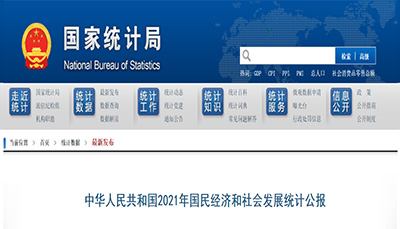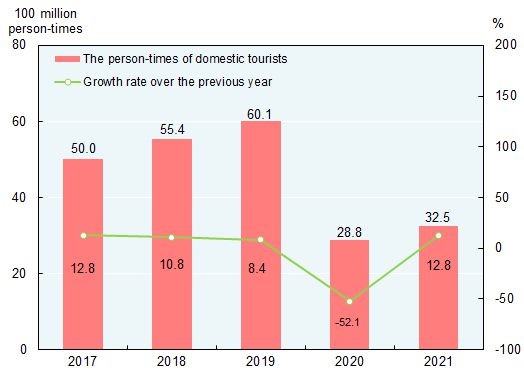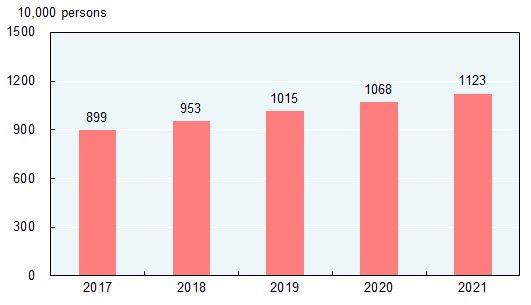



IV. Culture and Tourism, Public Health and Sports
By the end of 2021, there were 2,044 art-performing groups, 3,671 museums, and 3,317 cultural centers throughout China. A total of 3,217 public libraries received 728.98 million people. Subscribers to cable television programs numbered 201 million, among which 195 million subscribed to digital cable television programs. At the same time, radio and television broadcasting coverage rates were 99.5 percent and 99.7 percent respectively. A total of 6,736 episodes of 194 TV series and 78,372 minutes of TV cartoons were made in 2021, as well as 565 feature movies and 175 popular science movies, documentaries, animation and special movies. A total of 27.6 billion copies of newspapers and 2.0 billion copies of magazines were issued and 11.0 billion copies of books were published, with the average number of books possessed per person being 7.76 copies. Meanwhile, there were 4,233 archives in China and 189.31 million files were made accessible to the public. The business revenue of enterprises above the designated size engaged in culture and related industries reached 11,906.4 billion yuan, up by 16.0 percent over that of the previous year on a comparable basis.
The year 2021 registered 3.25 billion domestic tourists, up by 12.8 percent over that of the previous year. Among them, 2.34 billion were from urban areas, with an increase of 13.4 percent, and 900 million from rural areas, with an increase of 11.1 percent. Domestic tourism revenue was 2,919.1 billion yuan, up by 31.0 percent. Of this total, tourists from urban areas spent 2,364.4 billion yuan, up by 31.6 percent, and tourists from rural areas spent 554.7 billion yuan, up by 28.4 percent.

Figure 12: The Person-times of Domestic Tourists and Its Growth Rates 2017-2021
By the end of 2021, there were 1,031,000 medical and health institutions in China, including 37,000 hospitals, among which, 12,000 were public and 25,000 were private. Of the 977,000 medical and health institutions at grass-root level, there were 35,000 town and township health centers, 36,000 community health service centers, 307,000 clinics, and 599,000 village clinics. Of the 13,000 professional public health institutions, 3,380 were disease control and prevention centers and 2,790 were health monitoring institutions. Meanwhile, there were 11.23 million medical technical personnel in China, including 4.27 million licensed doctors and licensed assistant doctors and 5.02 million registered nurses. The medical and health institutions in China possessed 9.57 million beds, with 7.48 million in hospitals and 1.44 million in township health centers. The total number of medical visits and hospital discharges in 2021 reached 8.53 billion and 240 million respectively. A total of 102,314 confirmed cases of COVID-19 were reported nationwide, with 94,792 infected being cured and discharged from hospital and 4,636 passing away. A total of 2,835.33 million doses of COVID-19 vaccines were administered nationwide and a total of 11,937 medical and health institutions across the country provided nucleic acid testing services, with the daily testing capacity reaching 41.68 million.

Figure 13: Year-end Number of Medical Technical Personnel 2017-2021
There were altogether 3.971 million sports venues by the end of 2021, with a total floor area of 3.41 billion square meters and the per capita floor area of 2.41 square meters. In 2021, Chinese athletes won 67 world championships in 16 sports events and broke 12 world records. At the 32nd Olympic Games, Chinese athletes won 38 gold medals and a total of 88 medals, ranking the second in the Olympic gold medal tally and overall medal count. Chinese physically-challenged athletes won 110 world championships in 5 international sports competitions. At the 16th Paralympic Games, Chinese athletes won 96 gold medals and a total of 207 medals, topping the gold medal tally and overall medal count for the fifth consecutive time.
V. Resources, Environment and Emergency Management
In 2021, the total supply of state-owned land for construction was 690 thousand hectares, an increase of 4.8 percent over that of the previous year. Of this total, the land supply for industry, mining and warehousing was 175 thousand hectares, up by 4.9 percent; that for real estate was 136 thousand hectares, down by 12.2 percent; and that for infrastructure facilities was 379 thousand hectares, up by 12.7 percent.
The total stock of water resources in 2021 was 2,952.0 billion cubic meters. With an increase of 1.9 percent over 2020, the total water consumption reached 592.1 billion cubic meters, of which water consumption for living purposes up by 5.3 percent, for industrial use up by 2.0 percent, for agricultural use up by 0.9 percent, and artificial recharge for environmental and ecological use up by 2.9 percent. Water consumption per 10,000 yuan of GDP was 54 cubic meters, a decline of 5.8 percent over that of the previous year. Water consumption per 10,000 yuan of industrial value added was 31 cubic meters, down by 7.0 percent. Per capita water consumption was 419 cubic meters, up by 1.8 percent over that of the previous year.
In 2021, the total area of afforestation reached 3.60 million hectares, of which 1.34 million were afforested by manpower, accounting for 37.1 percent of the total. The land area improved by grass plantation was 3.07 million hectares. By the end of 2021, there were 474 national natural reserves and 5 national parks. A total of 62 thousand square kilometers of land was saved from soil erosion.
Preliminary estimation indicated that the total energy consumption in 2021 amounted to 5.24 billion tons of standard coal equivalent, up by 5.2 percent over that of 2020. The consumption of coal increased by 4.6 percent, crude oil up by 4.1 percent, natural gas up by 12.5 percent, and electric power up by 10.3 percent. The consumption of coal accounted for 56.0 percent of the total energy consumption, 0.9 percentage point lower than that of 2020, while clean energy consumption, such as natural gas, hydropower, nuclear power, wind power and solar power, accounted for 25.5 percent, 1.2 percentage points higher. The comprehensive energy consumption per unit calcium carbide by key energy-intensive industrial enterprises went down by 5.3 percent, per unit synthetic ammonia was the same as that of the previous year, per ton steel down by 0.4 percent, and per unit electrolytic aluminium down by 2.1 percent. The standard coal consumption per kilowatt-hour of thermal power generation decreased by 0.5 percent. The carbon dioxide emission per 10,000 yuan worth of GDP was cut by 3.8 percent.

Figure 14: The Proportion of Clean Energy Consumption in the Total Energy Consumption 2017-2021
The area of offshore oceanic water meeting the national quality standard of Grade I and II accounted for 81.3 percent, that of Grade III standard accounted for 5.2 percent, and that of Grade IV or inferior accounted for 13.5 percent. Of the 324 cities subject to urban regional daytime acoustic environment monitoring, 4.9 percent were evaluated as excellent, 61.7 percent as good, 31.5 percent as average, and 1.9 percent as poor. The average temperature in 2021 was 10.53℃, up by 0.28℃ compared with that of the previous year. Typhoons hit China 5 times in the same year.
In 2021, natural disasters hit 11.74 million hectares of crops, of which 1.63 million were demolished. A direct economic loss of 247.7 billion yuan was caused by flooding, waterlogging and geological disasters, 20.1 billion yuan by droughts, 13.3 billion yuan by low temperature, frost and snow, and 3.0 billion yuan by oceanic disasters. The country recorded 20 earthquakes of magnitude 5.0 and over, causing a direct economic loss of about 10.7 billion yuan. The year 2021 also witnessed 616 forest fires, with 4 thousand hectares of forests being damaged.
The death toll due to work accidents amounted to 26,307 people. Work accidents in industrial, mining and commercial companies caused 1.374 deaths out of every 100 thousand employees, up by 5.6 percent over that of 2020. The death toll for one million tons of coal produced in coalmines was 0.045 people, down by 23.7 percent. The road traffic death toll per 10 thousand vehicles was 1.57 people, down by 5.4 percent.
Edited by Wang Miao with reference to
<http://www.gov.cn/xinwen/2022-02/28/content_5676015.htm> and <http://www.stats.gov.cn/english/PressRelease/202202/t20220227_1827963.html>